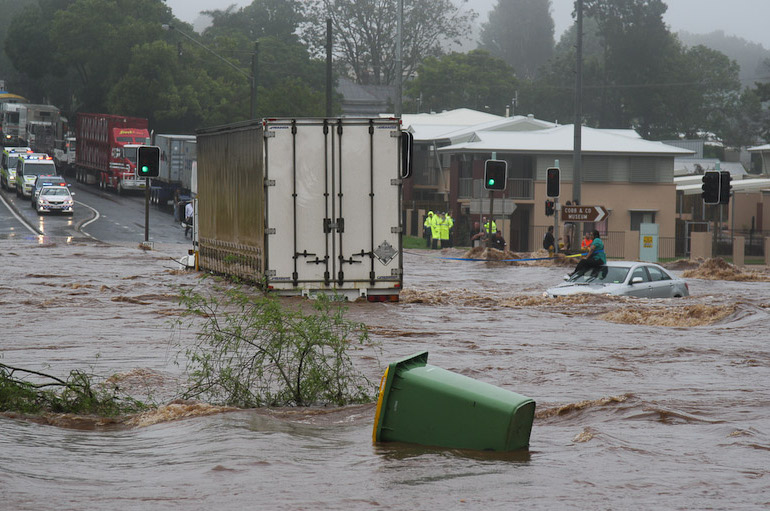A woman trapped on the roof of her car awaits rescue during the 2010-11 Toowoomba flash flood.
Attribution: Kingbob86 (Timothy)
Unprecedented but not unexpected
We have all been struck by the devastating flooding in Queensland and New South Wales. Stories of lives and livelihoods lost, businesses crushed, people injured, and homes left uninhabitable have shaken our nation. In fact, the floods have been confirmed as “one of the most extreme disasters in Australia’s history” (The Climate Council, 2022). Brisbane was hit by a “rain bomb” that dumped 60 per cent of their average rainfall in three days. The severity and speed of the flooding emergency caught many by surprise, record flood levels for several rivers were smashed, and a record number of rescues carried out.
The PM, Scott Morrison, declared this catastrophic event a national emergency and called it an unprecedented “1-in-500 year event” that “no-one was predicting.” But was it? Was the government warned? What is the science behind this extreme recent flooding event? What are the chances of it happening again? And how should Australia respond now?
Below, Lighter Footprints offers some answers to these challenging questions.
Climate change ‘supercharged’ the flooding
Climate scientists have confirmed that climate change ‘supercharged’ the flooding. For every degree of warming, the atmosphere holds 7 per cent more moisture. Australia’s climate has already warmed 1.4 degrees above preindustrial levels. The resultant atmosphere is wetter and warmer, increasing the intensity and volume of water in a downpour. Globally, scientists predict that the frequency of such intense rainfall events is likely to double with each degree of warming. In short, the extent of the floods was significantly escalated by climate change, and as the planet warms, the risk of flooding disasters increases. Read more here and here.
The government was briefed
Emergency Leaders for Climate Action did brief the government about the high risks of flooding during this La Nina summer. Sadly, their warnings were not heeded. The escalating risks of flooding, high-intensity cyclones, bushfires, and heatwaves due to climate change have also all been clearly outlined across reputable scientific platforms like the UN’s IPCC, CSIRO, and the Climate Council.
Unchecked climate change will also devastate our economy
In addition to lives lost, health impacts, infrastructure and environmental damage, the flooding event is costing Australia economically. The Insurance Council of Australia estimates costs of flood-related claims were $2.307bn as of 21 March. Natural disaster risks are causing insurance premiums to escalate. Further, the overall economic implications of inaction on climate change in Australia are astronomical. Deloitte Access Economics estimates that unchecked climate change will result in 880,000 jobs and $3.4 trillion lost in GDP by 2070. Read more here.
Action on climate change is an opportunity
In the aftermath of such a calamitous disaster as these floods, it is apparent that the world is now on a precipice. Australia has been ‘called out’ by the UN secretary general for our ‘holdout’ on setting meaningful emissions reductions targets. We can, and must, do more to prevent an escalation of these extreme events. As members of a wealthy, developed nation with one of the highest per-capita emissions in the world, we Australians have a moral duty to significantly reduce our collective impact on our climate. As a country blessed with abundant renewable energy resources, we are missing a huge opportunity to capitalise economically on a decarbonisation transition that will benefit all life on earth.
What you can do
Right now, the two most impactful things each of us individuals can do, are talking openly with others about climate change and voting for candidates who will prioritise meaningful climate action in parliament. See our #VoteClimate Action page and our Reasons to Vote Climate page for more information.
Amy Hiller is active within Lighter Footprints, is married with two young children and lives in Kew

